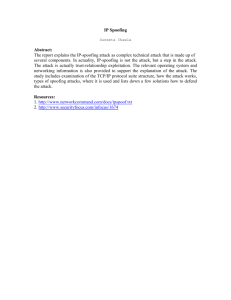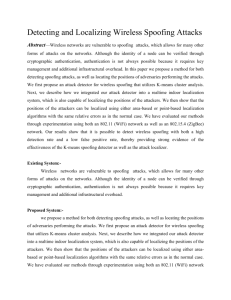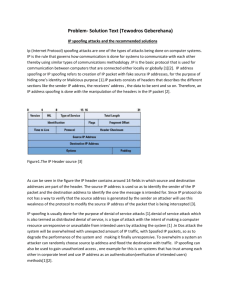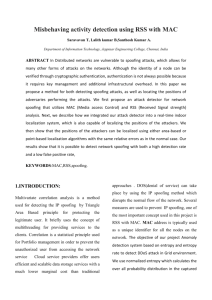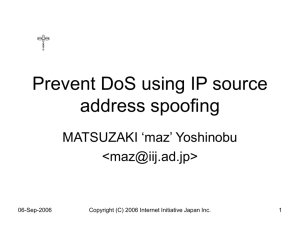Spoofing Attacks
advertisement
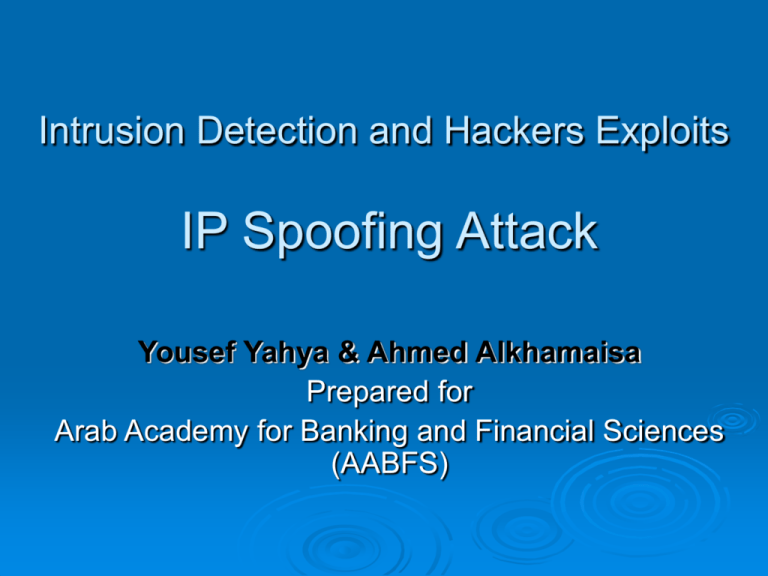
Intrusion Detection and Hackers Exploits IP Spoofing Attack Yousef Yahya & Ahmed Alkhamaisa Prepared for Arab Academy for Banking and Financial Sciences (AABFS) IP spoofing IP spoofing is a technique used to gain unauthorized access to computers, where by the attacker sends messages to a computer with a forging IP address indicating that the message is coming from a trusted host. Attacker puts an internal, or trusted, IP address as its source. The access control device sees the IP address as trusted and lets it through. IP Spoofing IP spoofing occurs when a hacker inside or outside a network impersonates the conversations of a trusted computer. Two general techniques are used during IP spoofing: • A hacker uses an IP address that is within the range of trusted IP addresses. • A hacker uses an authorized external IP address that is trusted. Uses for IP spoofing include the following: • IP spoofing is usually limited to the injection of malicious data or commands into an existing stream of data. • A hacker changes the routing tables to point to the spoofed IP address, then the hacker can receive all the network packets that are addressed to the spoofed address and reply just as any trusted user can. Basic Concept of IP Spoofing A www.carleton.ca 10.10.10.1 134.117.1.60 http://www.carleton.ca 10.10.10.1 134.117.1.60 Src_IP dst_IP Any (>1024) Src_port 80 dst_port spoofed 11.11.11.1 134.117.1.60 Src_IP dst_IP Any (>1024) Src_port 80 dst_port IP Spoofing Why IP Spoofing is easy? Problem with the Routers. Routers look at Destination addresses only. Authentication based on Source addresses only. To change source address field in IP header field is easy. Spoofing Attacks: There are a few variations on the types of attacks that using IP spoofing. Spoofing is classified into :1.non-blind spoofing This attack takes place when the attacker is on the same subnet as the target that could see sequence and acknowledgement of packets. Using the spoofing to interfere with a connection that sends packets along your subnet. Spoofing Attacks: impersonation sender partner Oh, my partner sent me a packet. I’ll process this. victim IP Spoofing Three-way handshake Intruder SYN(A) ACK(A+1) SYN(B) ACK(B+1) A B trusted host Spoofing Attacks: 2. Blind spoofing This attack may take place from outside where sequence and acknowledgement numbers are unreachable. Attackers usually send several packets to the target machine in order to sample sequence numbers, which is doable in older days . Using the spoofing to interfere with a connection (or creating one), that does not send packets along your cable. Spoofing Attacks: flooding attack sender Oops, many packets are coming. But, who is the real source? victim Spoofing Attacks: 3.Man in the Middle Attack This is also called connection hijacking. In this attacks, a malicious party intercepts a legitimate communication between two hosts to controls the flow of communication and to eliminate or alter the information sent by one of the original participants without their knowledge. Spoofing Attacks: reflection ip spoofed packet sender Oops, a lot of replies without any request… src: victim dst: reflector victim reflector Spoofing Attacks: 4.Denial of Service Attack conducting the attack, attackers spoof source IP addresses to make tracing and stopping the DoS as difficult as possible. When multiple compromised hosts are participating in the attack, all sending spoofed traffic, it is very challenging to quickly block the traffic. IP spoofing is almost always used in denial of service attacks (DoS), in which attackers are concerned with consuming bandwidth and resources by flooding the target with as many packets as possible in a short amount of time. To effectively Spoofing Attacks: IP spoofing can also be a method of attack used by network intruders to defeat network security measures, such as authentication based on IP addresses. This method of attack on a remote system can be extremely difficult, as it involves modifying thousands of packets at a time. This type of attack is most effective where trust relationships exist between machines. For example, it is common on some corporate networks to have internal systems trust each other, so that a user can log in without a username or password provided they are connecting from another machine on the internal network (and so must already be logged in). By spoofing a connection from a trusted machine, an attacker may be able to access the target machine without authenticating . SMURF ATTACK Send ICMP ping packet with spoofed IP source address to a LAN which will broadcast to all hosts on the LAN Each host will send a reply packet to the spoofed IP address leading to denial of service Misconception of IP Spoofing: A common misconception is that "IP Spoofing" can be used to hide your IP address while surfing the Internet, chatting on-line, sending e-mail, and so forth. This is generally not true. Forging the source IP address causes the responses to be misdirected, meaning you cannot create a normal network connection. However, IP spoofing is an integral part of many networks that do not need to see responses. Impact Current intruder activity in spoofing source IP addresses can lead to unauthorized remote root access to systems behind a filtering-router firewall. After gaining root access and taking over existing terminal and login connections, intruders can gain access to remote hosts. Detection of IP Spoofing: 1. If you monitor packets using networkmonitoring software such as netlog, look for a packet on your external interface that has both its source and destination IP addresses in your local domain. If you find one, you are currently under attack. Detection of IP Spoofing: 2. Another way to detect IP spoofing is to compare the process accounting logs between systems on your internal network. If the IP spoofing attack has succeeded on one of your systems, you may get a log entry on the victim machine showing a remote access; on the apparent source machine, there will be no corresponding entry for initiating that remote access. Source Address Validation : Check the source IP address of IP packets If filter invalid source address filter close to the packets origin as possible filter precisely as possible no networks allow IP spoofing, we can eliminate these kinds of attacks close to the origin You are spoofing! You are spoofing! RT.a× srcip: 0.0.0.0 srcip: 0.0.0.0 RT.b You are spoofing! srcip: 0.0.0.0 10.0.0.0/23 × srcip: 10.0.0.1 × × srcip: 10.0.0.1 Hmm, this looks ok...but.. You are spoofing! × 10.0.3.0/24 srcip: 10.0.0.1 You are spoofing! we can check and drop the packets which have unused address everywhere, but used space can be checked before aggregation Prevention IP spoofing The best method of preventing the IP spoofing problem is to install a filtering router that restricts the input to your external interface (known as an input filter) by not allowing a packet through if it has a source address from your internal network. In addition, you should filter outgoing packets that have a source address different from your internal network in order to prevent a source IP spoofing attack originating from your site. Prevention IP spoofing If your vendor’s router does not support filtering on the inbound side of the interface or if there will be a delay in incorporating the feature into your system, you may filter the spoofed IP packets by using a second router between your external interface and your outside connection. Configure this router to block, on the outgoing interface connected to your original router, all packets that have a source address in your internal network. Prevention of IP Spoofing: To prevent IP spoofing happen in your network, the following are some common practices: 1- Avoid using the source address authentication. Implement cryptographic authentication system-wide. 2- Configuring your network to reject packets from the Net that claim to originate from a local address. 3- Implementing ingress and egress filtering on the border routers and implement an ACL (access control list) that blocks private IP addresses on your downstream interface. If you allow outside connections from trusted hosts, enable encryption sessions at the router. Filtering if src_addr is from 10.10.0.0 then drop else forward 10.10.0.0 10.10.10.0 if src_addr is from 10.10.0.0 then forward else drop
